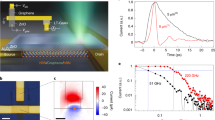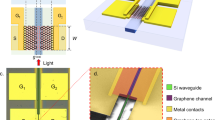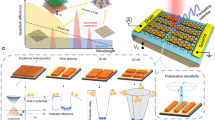Abstract
Charge-coupled devices are widely used imaging technologies. However, their speed is limited due to the complex readout process, which involves sequential charge transfer between wells, and their spectral bandwidth is limited due to the absorption limitations of silicon. Here we report graphene charge-injection photodetectors. The devices have a deep-depletion silicon well for charge integration, single-layer graphene for non-destructive direct readout and multilayer graphene for infrared photocharge injection. The photodetectors offer broadband imaging from ultraviolet (around 375 nm) to mid-infrared (around 3.8 μm), a conversion gain of 700 pA per electron, a responsivity above 0.1 A W−1 in the infrared region and a fast response time under 1 μs.
This is a preview of subscription content, access via your institution
Access options
Access Nature and 54 other Nature Portfolio journals
Get Nature+, our best-value online-access subscription
$29.99 / 30 days
cancel any time
Subscribe to this journal
Receive 12 digital issues and online access to articles
$119.00 per year
only $9.92 per issue
Buy this article
- Purchase on Springer Link
- Instant access to full article PDF
Prices may be subject to local taxes which are calculated during checkout



Similar content being viewed by others
Data availability
Source data are provided with this paper. The data that support the other findings of this study are available from the corresponding authors upon reasonable request.
References
Boyle, W. S. & Smith, G. E. Charge coupled semiconductor devices. Bell Syst. Tech. J. 49, 587–593 (1970).
Amelio, G. F. et al. Experimental verification of the charge coupled device concept. Bell Syst. Tech. J. 49, 593–600 (1970).
Smith, G. E. Nobel lecture: the invention and early history of the CCD. Rev. Mod. Phys. 82, 2307–2312 (2010).
Nakata, S. et al. A wearable pH sensor with high sensitivity based on a flexible charge-coupled device. Nat. Electron. 1, 596–603 (2018).
Zhang, H.-F. et al. Scientific CCD camera for the CSTAR2 telescope in Antarctica. J. Astron. Telesc. Instrum. Syst. 5, 036002 (2019).
Tiffenberg, J. et al. Single-electron and single-photon sensitivity with a silicon skipper CCD. Phys. Rev. Lett. 119, 131802 (2017).
Murata, M. et al. A 24.3 Me− full well capacity CMOS image sensor with lateral overflow integration trench capacitor for high precision near infrared absorption imaging. in 2018 IEEE International Electron Devices Meeting (IEDM) 10.3.1–10.3.4 (IEEE, 2018).
Kim, W.-T. et al. A high full well capacity CMOS image sensor for space applications. Sensors 19, 1505 (2019).
Durini, D. & Arutinov, D. in High Performance Silicon Imaging 2nd edn (ed Durini, D.) 25–73 (Woodhead Publishing, 2020).
Magnan, P. Detection of visible photons in CCD and CMOS: a comparative view. Nucl. Instrum. Methods Phys. Res. A 504, 199–212 (2003).
Luštica, A. CCD and CMOS image sensors in new HD cameras. in Proc. ELMAR-2011 133–136 (IEEE, 2011).
Marcelot, O. et al. Study of CCD transport on CMOS imaging technology: comparison between SCCD and BCCD, and ramp effect on the CTI. IEEE Trans. Electron Devices 61, 844–849 (2014).
Gamal, A. E. & Eltoukhy, H. CMOS image sensors. IEEE Circuits Devices Mag. 21, 6–20 (2005).
Suzuki, M. et al. An over 1Mfps global shutter CMOS image sensor with 480 frame storage using vertical analog memory integration. in 2016 IEEE International Electron Devices Meeting 8.5.1–8.5.4 (IEEE, 2016).
Bigas, M. et al. Review of CMOS image sensors. Microelectron. J. 37, 433–451 (2006).
Shepherd, F. D. & Yang, A. C. Silicon Schottky retinas for infrared imaging. in International Electron Devices Meeting 310–313 (IEEE, 1973).
Yutani, N. et al. 1040*1040 element PtSi Schottky-barrier IR image sensor. in International Electron Devices Meeting 1991 175–178 (IEEE, 1991).
Denda, M. et al. 4-band*4096-element Schottky-barrier infrared linear image sensor. IEEE Trans. Electron Devices 38, 1131–1135 (1991).
Leitz, C. et al. Development of germanium charge-coupled devices. in Proc. SPIE 10709 High Energy, Optical, and Infrared Detectors for Astronomy VIII 1070908 (International Society for Optics and Photonics, 2018).
Manda, S. et al. High-definition visible-SWIR InGaAs image sensor using Cu-Cu bonding of III-V to silicon wafer. in 2019 IEEE International Electron Devices Meeting (IEDM) 16.7.1–16.7.4 (IEEE, 2019).
Wang, Y. et al. Fast uncooled mid-wavelength infrared photodetectors with heterostructures of van der Waals on epitaxial HgCdTe. Adv. Mater. 34, 2107772 (2022).
Goossens, S. et al. Broadband image sensor array based on graphene–CMOS integration. Nat. Photon. 11, 366–371 (2017).
Akinwande, D. et al. Graphene and two-dimensional materials for silicon technology. Nature 573, 507–518 (2019).
Kong, W. et al. Path towards graphene commercialization from lab to market. Nat. Nanotechnol. 14, 927–938 (2019).
Zhu, Y. et al. Mass production and industrial applications of graphene materials. Natl Sci. Rev. 5, 90–101 (2017).
Howell, S. W. et al. Graphene-insulator-semiconductor junction for hybrid photodetection modalities. Sci. Rep. 7, 14651 (2017).
Ruiz, I. et al. Interface defect engineering for improved graphene-oxide-semiconductor junction photodetectors. ACS Appl. Nano Mater. 2, 6162–6168 (2019).
Liu, C.-H. et al. Graphene photodetectors with ultra-broadband and high responsivity at room temperature. Nat. Nanotechnol. 9, 273–278 (2014).
Chen, X. et al. Graphene hybrid structures for integrated and flexible optoelectronics. Adv. Mater. 32, 1902039 (2019).
Bao, Q. & Loh, K. P. Graphene photonics, plasmonics, and broadband optoelectronic devices. ACS Nano 6, 3677–3694 (2012).
Zhang, B. Y. et al. Broadband high photoresponse from pure monolayer graphene photodetector. Nat. Commun. 4, 1811 (2013).
Yu, X. et al. A high performance, visible to mid-infrared photodetector based on graphene nanoribbons passivated with HfO2. Nanoscale 8, 327–332 (2016).
Yu, X. et al. Narrow bandgap oxide nanoparticles coupled with graphene for high performance mid-infrared photodetection. Nat. Commun. 9, 4299 (2018).
Massicotte, M. et al. Photo-thermionic effect in vertical graphene heterostructures. Nat. Commun. 7, 12174 (2016).
Liu, Y. et al. Van der Waals integration before and beyond two-dimensional materials. Nature 567, 323–333 (2019).
Wang, Y. et al. Van der Waals contacts between three-dimensional metals and two-dimensional semiconductors. Nature 568, 70–74 (2019).
Shimatani, M. et al. Giant Dirac point shift of graphene phototransistors by doped silicon substrate current. AIP Adv. 6, 035113 (2016).
Guo, X. et al. High-performance graphene photodetector using interfacial gating. Optica 3, 1066–1070 (2016).
Zhou, F. et al. Optoelectronic resistive random access memory for neuromorphic vision sensors. Nat. Nanotechnol. 14, 776–782 (2019).
Adinolfi, V. & Sargent, E. H. Photovoltage field-effect transistors. Nature 542, 324–327 (2017).
Ioannou, D. E. & Dimitriadis, C. A. A SEM-EBIC minority-carrier diffusion-length measurement technique. IEEE Trans. Electron Devices 29, 445–450 (1982).
Castaldini, A. et al. Determination of bulk and surface transport properties by photocurrent spectral measurements. Appl. Phys. A 71, 305–310 (2000).
Tan, S. et al. Ultrafast multiphoton thermionic photoemission from graphite. Phys. Rev. X 7, 011004 (2017).
Berashevich, J. & Chakraborty, T. Interlayer repulsion and decoupling effects in stacked turbostratic graphene flakes. Phys. Rev. B 84, 033403 (2011).
Shallcross, S. et al. Electronic structure of turbostratic graphene. Phys. Rev. B 81, 165105 (2010).
Ma, Q. et al. Tuning ultrafast electron thermalization pathways in a van der Waals heterostructure. Nat. Phys. 12, 455–459 (2016).
Yuan, S. et al. Room temperature graphene mid-infrared bolometer with a broad operational wavelength range. ACS Photonics 7, 1206–1215 (2020).
Fang, B. et al. Bidirectional mid-infrared communications between two identical macroscopic graphene fibres. Nat. Commun. 11, 6368 (2020).
Xu, J. et al. Ultra-broadband graphene-InSb heterojunction photodetector. Appl. Phys. Lett. 111, 051106 (2017).
Yin, J. et al. Engineered tunneling layer with enhanced impact ionization for detection improvement in graphene/silicon heterojunction photodetectors. Light Sci. Appl. 10, 113 (2021).
Zhu, H. et al. Metal–oxide–semiconductor-structured MgZnO ultraviolet photodetector with high internal gain. J. Phys. Chem. C 114, 7169–7172 (2010).
Wang, W. J. et al. Metal–insulator–semiconductor–insulator–metal structured titanium dioxide ultraviolet photodetector. J. Phys. D: Appl. Phys. 43, 045102 (2010).
Janesick, J. R. Scientific charge-coupled devices. Opt. Eng. 26, 268692 (2001).
Lahav, A. et al. in High Performance Silicon Imaging 2nd edn (ed Durini, D.) 95–117 (Woodhead Publishing, 2020).
Wan, X. et al. A self-powered high-performance graphene/silicon ultraviolet photodetector with ultra-shallow junction: breaking the limit of silicon? npj 2D Mater. Appl. 1, 4 (2017).
Peng, L. et al. Multifunctional macroassembled graphene nanofilms with high crystallinity. Adv. Mater. 33, 2104195 (2021).
Grojo, D. et al. Long-wavelength multiphoton ionization inside band-gap solids. Phys. Rev. B 88, 195135 (2013).
Briggman, K. A. et al. Imaging and autocorrelation of ultrafast infrared laser pulses in the 3–11-μm range with silicon CCD cameras and photodiodes. Opt. Lett. 26, 238–240 (2001).
Acknowledgements
We thank C. Jin and X. Zhang for help on the NIR test and L. Chen and H. Zhu for help on the MIR test. We thank E. Li, W. Yin, D. Dai, W. Chen, K. Huang, Z. Tan, H. Shen, C. Li, S. Song, Q. Xiong and T. Low for valuable discussions. Y.X. acknowledges the support of this work by NSFC (grant nos.92164106, 61874094, 62090030 and 52090030); the Fundamental Research Funds for the Central Universities (K20200060 and 2021FZZX001-17); ZJU Micro-Nano Fabrication Center.
Author information
Authors and Affiliations
Contributions
Y.X., H.G. and X.D. designed the research. Y.X., H.G., W. L. and J.L. designed the experiment. L.P. and C.G. synthesized the MLG and developed the transfer methods. K.L. synthesized the SLG. Y.X., W.L., J.L., C.L. and Y.L. fabricated the devices and carried out the measurements. Y.X., L. Liu and L. Li assisted in part of the experiment. Y.X., H.G., P.W., S.C.B., K.S., Z.S., T.H. and B.Y. helped improve the manuscript. Y.X., X.W., C.G., B.Y., and X.D. guided the project. All the authors contributed to interpreting the data and writing the manuscript.
Corresponding authors
Ethics declarations
Competing interests
The authors declare no competing interests.
Peer review
Peer review information
Nature Electronics thanks Lukas Mennel and the other, anonymous, reviewer(s) for their contribution to the peer review of this work.
Additional information
Publisher’s note Springer Nature remains neutral with regard to jurisdictional claims in published maps and institutional affiliations.
Supplementary information
Supplementary Information
Supplementary Text 1–10, Figs. 1–16 and Table 1.
Supplementary Data
Data for Supplementary Figs. 1, 4–11 and 16.
Supplementary Data
Data for Supplementary Fig. 15.
Source data
Source Data Fig. 2
Statistical source data.
Source Data Fig. 3
Statistical source data.
Rights and permissions
About this article
Cite this article
Liu, W., Lv, J., Peng, L. et al. Graphene charge-injection photodetectors. Nat Electron 5, 281–288 (2022). https://doi.org/10.1038/s41928-022-00755-5
Received:
Accepted:
Published:
Issue Date:
DOI: https://doi.org/10.1038/s41928-022-00755-5
This article is cited by
-
Multidimensional detection enabled by twisted black arsenic–phosphorus homojunctions
Nature Nanotechnology (2024)
-
Synergistic-potential engineering enables high-efficiency graphene photodetectors for near- to mid-infrared light
Nature Communications (2024)
-
Theoretical investigations on the growth of graphene by oxygen-assisted chemical vapor deposition
Nano Research (2024)
-
Low-dimensional wide-bandgap semiconductors for UV photodetectors
Nature Reviews Materials (2023)
-
Graphene-based optofluidic tweezers for refractive-index and size-based nanoparticle sorting, manipulation, and detection
Scientific Reports (2023)



